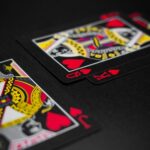A deck of cards includes four suits and 13 ranks, including the ace, king, queen, jack, and 10 numbered cards. Of the four suits, three are ranked and one has only face cards that aren’t ranked. Each suit ranks in this order from highest to lowest: hearts, diamonds, clubs, and spades. The heart’s suite contains eight face cards: the king, queen, jack, and 10 numbered cards from 2 to 10. The ace card is considered the highest card in a deck of cards because it outranks every other card in both the suit’s suit ranking and its number ranking as well.

How many hearts are in a deck of cards?
There are 24 hearts in each deck of cards. The playing card we refer to as the heart is actually two overlapping keys that appear together on one side and alone on another. Wherever you see hearts, spades, clubs, or diamonds, each deck contains just one symbol representing all four suits. So there are only 24 total hearts per deck; they’re just scared by all four suits.
As for why these particular symbols were chosen to represent different suits, that’s still up for debate. According to some historians, early French playing cards featured swords (or fleur-de-lis), cups (or chalices), and coins (or shields).
Over time, these designs evolved into today’s hearts, spades, clubs, and diamonds. Others believe both symbols originated from Roman coins that were stamped with X marks in place of numerals because Romans didn’t have letters like X or I—only numbers. Still, others think it has something to do with hand gestures used when playing earlier versions of card games. But whatever their origin story may be, it’s hard not to love those charming little symbols!
The Suit – Jack, Queen, King, Ace:
In each suite, there are three face cards, one for each level. Their ranks are determined by how high their spot is within that suit and they always beat cards with lower spots. For example, a Jack will beat an Ace of another suit and a 10 will beat both. Aces rank highest but have no suit color associated with them; they can be used as wild cards when you need them most. In games like Spades or Euchre, Aces are actually the lowest because they’re not considered part of any suit (they’re trapped in spades).
The Queen, King, and Jack all represent different suits – hearts, diamonds, and clubs respectively. While they do hold value on their own, they also serve as enablers for bigger tricks you might want to pull off later on. Keep these guys handy! The Number Cards: The number cards range from 2-to 10 (with Jokers thrown into some decks) and come in every suit.
Each card has its own value which determines how many points it’s worth if it’s used during play – think hearts = 1 point while diamonds = 11 points. When two players lay down a card at once, whoever has a higher ranking wins automatically so watch out! If two players tie using identical ranked cards (two sevens), then whoever played second wins automatically instead.
The Card – Numbers 10-12:
The higher number of cards will have more hearts in them. Since there are only 12 numbers, and you need at least 10 hearts, that means that 4 of those numbers must have 2 hearts each (10+2=12), and 2 would have 3 each (6+3=9). That leaves one card with just 1 heart. Add it all up and you’ll see that you need 13 hearts. This means that 13 is your target number for how many hearts are in a deck of cards. If you’re close but not exactly sure, don’t worry too much about it.
If your answer is 11 or 12 then you can still get away with having 14 hearts in a deck of cards—just make sure they aren’t all bunched together on certain cards. So if there are two 6s, two 7s, and two 8s then don’t put any more than one heart on any of those four cards.
The Card – 5, 6, 7:
The game is played with 54 cards that include hearts, clubs, diamonds, and spades. Each suite has 13 cards, representing all four values: 5 (with an image of 1 red heart), 6 (picture of 2 red hearts), 7 (picture of 3 red hearts) and jack (of spades), queen (of clubs), king (of diamonds). The remaining 10 cards are numbered cards from 10 down to 2. There are no jokers or wild cards.
Clubs and spades are considered higher than diamonds and hearts. In other words, if two players have cards of equal value, they compare them according to their suits. So a seven of clubs beats a seven of hearts because clubs are higher than hearts. If two players have equal-value cards but different suits, then they compare their numbers – so eight beats a nine because it’s a lower number (2 vs. 3). Aces rank high regardless of suit or number; so for example, an ace beats a king regardless if you’re comparing one ace against one king or two kings against each other.
Q/J vs J/Q (and other popular myths):
In America, we refer to Jacks as Kings and Queens as Jacks. Since most Americans don’t call these cards by their real names (the French do), they can easily fall prey to misinformation regarding these cards. For example, many people think that two Jokers are included in every deck. Not true. Four hearts are used instead: King, Queen, Jack, and Ace. If you thought there were 16 hearts total – 8 red and 8 black – you’re not wrong; it’s just that there are four red and four black hearts per deck instead of one complete set for each color.
The Lovers – 8, 9:

The Ace of Hearts is usually high, it represents passion and true love. That’s why it is frequently featured on Valentine’s Day cards or wedding invitations. The Two of Hearts signifies that you have an even temperament and can always see both sides of any issue or argument. You’re often quite popular because people like your upbeat attitude and ability to make them feel good about themselves.
The Three of Hearts symbolizes that love is awakening within you, but there may be some complications ahead before you find true happiness. The Four of Hearts has been broken off by another lover who did not return its affection, leaving it lonely and vulnerable; so don’t expect to meet Mr./Ms. Right anytime soon!
Spades – A:
♠ Spades – 10: ♠ A Spades – Jack: ♠ J Spades – Queen: ♠ Q Spades – King: ♠ K Clubs – A: ♣ Clubs – 10: ♣ A Clubs – Jack: ♣ J Clubs – Queen: ♣ Q Clubs – King: ♣ K Diamonds – A:♥ Diamonds – 10:♥ A Diamonds – Jack:♥ J Diamonds – Queen:♥ Q Diamonds- King:♥ K Hearts-A:♥ Hearts-10 :♡ Hearts-Jack:♦ Hearts-Queen:♢ Hearts–King.:❤ Hearts-8 :♧ Hearts-9:♨ Hearts-10. ❦ Pips — The pips are used to determine what card it is.
The pips are all located on opposite sides of each card, and each suite has its own set of pips. There are four pips on each card, and they represent the face value of that card. That means that if you have an Ace, it will have one pip on top (which means 1), two pips on its left side (which means 2), and one pip on its right side (which means 1). Each suite has a different color for its pips as well, so you can tell which suit it is by looking at them.
Spades – K:
The spade is thought to be derived from an early symbol for foot (the shape also resembles half of a footprint). This would be consistent with its use on playing cards, as each suit represents one of four legs on which we stand. In many games, it is used for high-value cards and winning trick sequences – reinforcing its symbolic link with standing tall. As such, it is said that when someone plays all spades they are on their own two feet.
Diamonds – Q, J, T, and 9:
These are often called spades, even though they’re diamonds. This is a common mistake, as there are only three spades in every deck. Three is not many more than once, so don’t be surprised if you run into someone calling them spades. That person could play cards for less than two cents per day and be mostly on par with everyone else at his table. Since we’re going off subject here, did you know that all fours and sevens were once clubs? The change happened around 1874 when clubs were taken out of playing cards and replaced with diamonds.
Clubs – 3:
The Three Club symbolizes unity, community, and harmony. It teaches us that we have more power when we work together as opposed to alone. This card is representative of friendship, family, and relationships that are based on mutual understanding and loyalty. When you feel like you are carrying too much weight on your shoulders by yourself, it’s time to look for support from others.
This card may also mean that you or someone you know is experiencing emotional upheaval. Change can be difficult at times but once things settle down, it will be easier than before! The Three Club reminds us all that even though we cannot always control what happens in our lives, we can always control how we react and approach things positively. Carry one if you need help overcoming isolation or negativity with your social circle.
Conclusion:
Ever wonder how many hearts are in a deck of cards? Good news: It’s relatively easy to figure out. The number will depend on what kind of deck you have, but for standard playing cards, it’s 52. And now you know! Remember, you can use FunTrivia whenever there’s a lull in the conversation and even quiz your friends on random facts. Whether you’re trying to win bar bets or find small ways to be more interesting around your friends, it can help with that too.
You won’t always need some small talk either – when it comes down to it if someone asks why do people use spades instead of clubs? they’re probably just waiting for an excuse to start talking about magic tricks anyway. Have fun with it!
Also, check out “Angel Number 919 Meaning“, ”Is Softonic Safe And Legal To Use” and ”How To Reheat Mcnugget”
Hi I’m Bilal Malik, a digital marketing and blogging expert holding years of experience.










